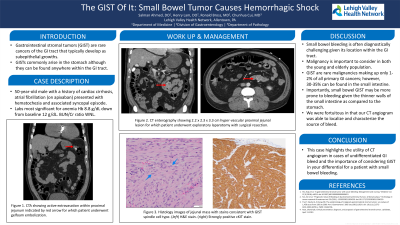Monday Poster Session
Category: GI Bleeding
P2535 - The GIST of it: Small Bowel Tumor Causes Hemorrhagic Shock
Monday, October 28, 2024
10:30 AM - 4:00 PM ET
Location: Exhibit Hall E

Has Audio

Salman Ahmed, DO
Lehigh Valley Health Network
Allentown, PA
Presenting Author(s)
Salman Ahmed, DO, Henry Lam, DO, Ronald Bross, MD, Chunhua Cui, MD
Lehigh Valley Health Network, Allentown, PA
Introduction: Gastrointestinal stromal tumor (GIST) are rare cancers of the GI tract that typically develop as subepithelial growths. While they most commonly arise in the stomach, GISTs can be found anywhere within the GI tract. Here, we present a rare case of hemorrhagic shock secondary to a jejunal GIST.
Case Description/Methods: A 50-year-old-male with a past medical history of cardiac cirrhosis and atrial fibrillation on apixaban presented with hematochezia and associated syncope. Labs on arrival were most significant for anemia with hemoglobin 8.8 g/dL, thrombocytopenia with platelets 135 thou/cmm, and mildly elevated PT/INR 1.5. Vitals were significant for tachycardia with heart rate 119 bpm and hypotension blood pressure 82/51 mmHg. CT angiogram revealed active extravasation within the proximal jejunum. Given positive CT angiogram, the patient underwent angiography of the superior mesenteric artery by interventional radiology which was negative for active extravasation. However, there were concerns for a hypervascular lesion correlating to the cross-sectional imaging findings; therefore, empiric gelfoam embolization of selective jejunal branches was performed. Follow up CT enterography confirmed these findings revealing a 2.2 x 2.3 x 3.3 cm hypervascular mass in the left upper quadrant jejunum. Given the location and hypervascular nature of the lesion, the patient underwent exploratory laparotomy by surgical oncology with small bowel resection of the mass. Pathology revealed low grade GIST spindle cell type that was positive for C-KIT and DOG1 tumor markers.
Discussion:
Small bowel bleeding is often diagnostically challenging given its location within the GI tract. Malignancy is certainly a differential to consider both in the young and elderly patient population. GIST are rare malignancies making up only 1-2% of all primary GI cancers; however, 30-35% can be found in the small intestine. We were fortuitous in that our CT angiogram was able to localize and characterize the source of bleed. Importantly, small bowel GIST may be more prone to bleeding given the thinner walls of the small intestine as compared to the stomach. This case highlights the utility of CT angiogram in cases of undifferentiated GI bleed and the importance of considering GIST in your differential for a patient with small bowel bleeding.
Disclosures:
Salman Ahmed, DO, Henry Lam, DO, Ronald Bross, MD, Chunhua Cui, MD. P2535 - The GIST of it: Small Bowel Tumor Causes Hemorrhagic Shock, ACG 2024 Annual Scientific Meeting Abstracts. Philadelphia, PA: American College of Gastroenterology.
Lehigh Valley Health Network, Allentown, PA
Introduction: Gastrointestinal stromal tumor (GIST) are rare cancers of the GI tract that typically develop as subepithelial growths. While they most commonly arise in the stomach, GISTs can be found anywhere within the GI tract. Here, we present a rare case of hemorrhagic shock secondary to a jejunal GIST.
Case Description/Methods: A 50-year-old-male with a past medical history of cardiac cirrhosis and atrial fibrillation on apixaban presented with hematochezia and associated syncope. Labs on arrival were most significant for anemia with hemoglobin 8.8 g/dL, thrombocytopenia with platelets 135 thou/cmm, and mildly elevated PT/INR 1.5. Vitals were significant for tachycardia with heart rate 119 bpm and hypotension blood pressure 82/51 mmHg. CT angiogram revealed active extravasation within the proximal jejunum. Given positive CT angiogram, the patient underwent angiography of the superior mesenteric artery by interventional radiology which was negative for active extravasation. However, there were concerns for a hypervascular lesion correlating to the cross-sectional imaging findings; therefore, empiric gelfoam embolization of selective jejunal branches was performed. Follow up CT enterography confirmed these findings revealing a 2.2 x 2.3 x 3.3 cm hypervascular mass in the left upper quadrant jejunum. Given the location and hypervascular nature of the lesion, the patient underwent exploratory laparotomy by surgical oncology with small bowel resection of the mass. Pathology revealed low grade GIST spindle cell type that was positive for C-KIT and DOG1 tumor markers.
Discussion:
Small bowel bleeding is often diagnostically challenging given its location within the GI tract. Malignancy is certainly a differential to consider both in the young and elderly patient population. GIST are rare malignancies making up only 1-2% of all primary GI cancers; however, 30-35% can be found in the small intestine. We were fortuitous in that our CT angiogram was able to localize and characterize the source of bleed. Importantly, small bowel GIST may be more prone to bleeding given the thinner walls of the small intestine as compared to the stomach. This case highlights the utility of CT angiogram in cases of undifferentiated GI bleed and the importance of considering GIST in your differential for a patient with small bowel bleeding.
Disclosures:
Salman Ahmed indicated no relevant financial relationships.
Henry Lam indicated no relevant financial relationships.
Ronald Bross indicated no relevant financial relationships.
Chunhua Cui indicated no relevant financial relationships.
Salman Ahmed, DO, Henry Lam, DO, Ronald Bross, MD, Chunhua Cui, MD. P2535 - The GIST of it: Small Bowel Tumor Causes Hemorrhagic Shock, ACG 2024 Annual Scientific Meeting Abstracts. Philadelphia, PA: American College of Gastroenterology.
